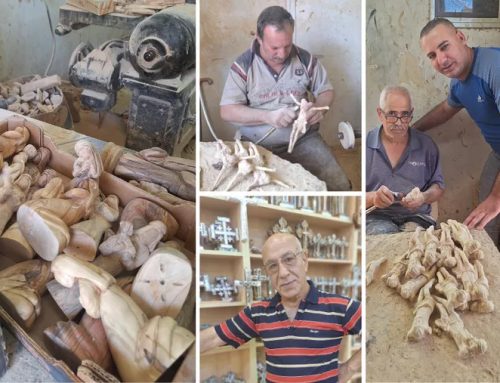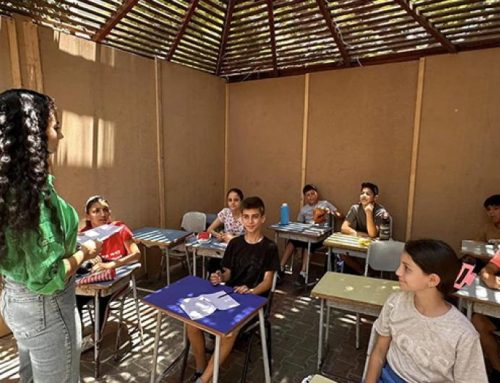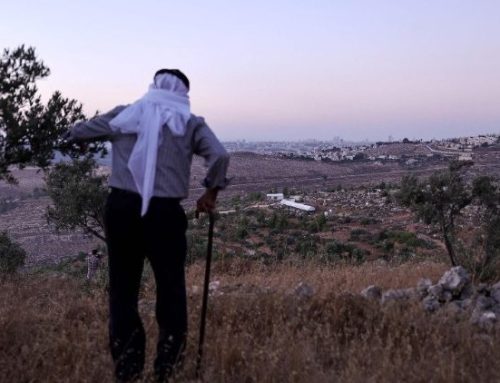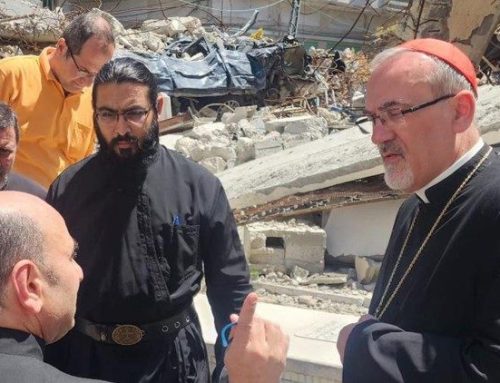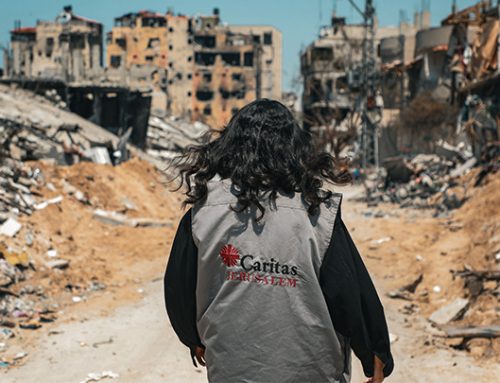Ma’an
Pope Benedict XVI did not shy away from comment on the Right of Return and Israel’s illegal separation wall as he spoke beneath the barrier’s shadow in Bethlehem’s Aida Refugee Camp at the culmination of a daylong visit on Wednesday.
“Towering over us as we gather here this afternoon is a stark reminder of the stalemate of relations between Israelis and Palestinians seem to have reached – the wall,” the pontiff told the 300 locals, officials, clerics and journalists crammed into a concrete UN schoolyard in the camp.
Israel’s 850 km-long concrete wall snakes through the interior of the West Bank, cutting into Bethlehem’s city center and partially encircling Aida Camp. The barrier was ruled illegal by the International Court of Justice in 2004. Israel says its purpose is to prevent Palestinian attacks.
To the refugees, Benedict said he wished to express his “solidarity with all the homeless Palestinians who long to be able to return to their birthplace or to live permanently in a homeland of their own.” He also grieved for those with divided families due to the “imprisonment on family members or restrictions on freedom of movement and…bereavement in the course of the hostilities. My heart goes out to all who suffer in this way.”
As he entered the camp school the pope could see the amphitheatre a planning committee constructed during the weeks before his arrival, but were ordered not to use by the Israeli military, who threatened to shut down the visit.
“On both sides of the wall, great courage is needed if fear and mistrust is to be overcome, if the urge to retaliate for loss or injury is to be resisted,” said Benedict.
“There has to be a willingness to take bold and imaginative initiatives towards reconciliation. If each insists on prior concessions from the other, the result can only be stalemate,” he said.
Benedict spoke in a schoolyard decorated with murals promoting the Right of Return, including idealized depictions of the Palestinian homeland lost in 1948 – lush streams, women in traditional garb carrying jugs of water. The area was also hung with banners calling for refugees’ right to return, and one quoting Pope John Paul II on his visit to Bethlehem in 2000.
“The Holy See has always recognized the Palestinian people have the natural right to a homeland and the right to be able to live in peace and tranquility – Pope John Paul II,” read the banner.
The pope was welcomed in the camp by Palestinian President Mahmoud Abbas, camp officials, and also Karen AbuZayd, the commissioner-general of UNRWA, the UN’s relief agency for Palestinian refugees, which administers services in the refugee camps.
AbuZayd thanked the pope “for acknowledging through your presence the aspiration of Palestinians for a normal life.” She also accepted from Benedict a 70,000 euro donation, which will be used to add three classrooms to the UN school.
The Aida event also included an exhibition of traditional Palestinian dance, set in part to Beethoven’s Fifth Symphony and a recitation of a poem written by the late Palestinian poet Mahmoud Darwish. The children of Palestinian prisoners presented the pontiff two letters from their parents.
Not shy from politics
Ending Israel’s siege of the Gaza Strip and establishing a homeland for Palestinians were two of the earlier requests Pope Benedict XVI made during his first two speeches in Bethlehem speaking to the Palestinian President and masses of assembled pilgrims in the presidential compound and Manger Square respectively.
Expectations for the pope’s visit were mixed, coming as it did less than four months after the last shell was dropped on Gaza, three days before scheduled unity talks and only hours after a foiled attempt by Palestinian President Mahmoud Abbas to form a new caretaker government.
As he received the pope at the presidential compound, Abbas called on Benedict to help end the suffering of the Palestinian people, establish a Palestinian state with Jerusalem as its capital living beside Israel, and to help guarantee the right of return for Palestinian refugees guaranteed under UN Resolution 194; A tall order for a figure also trying to mend fences with Israeli leaders following two issues over the Holy See and the Holocaust.
The Holy Father’s response was heartening, however. Responding to Abbas Benedict empathized with the plight of the Palestinians: “I know how much you have suffered and continue to suffer as a result of the turmoil that has afflicted this land for decades. My heart goes out to all the families who have been left homeless. This afternoon I will pay a visit to the Aida Refugee Camp, in order to express my solidarity with the people who have lost so much.”
Also in his speech the pope announced that “The Holy See supports the right of your people to a sovereign Palestinian homeland in the land of your forefathers, secure and at peace with its neighbors, within internationally recognized borders.”
The pontiff recognized Palestinians’ right “to contact between family members and access to the holy places,” and said “It is my earnest hope that the serious concerns involving security in Israel and the Palestinian Territories will soon be allayed sufficiently to allow greater freedom of movement.”
Pilgrims travel to Bethlehem by thousands
Busloads of pilgrims waited for the pope in Manger Square. For many of the devout, politics was not one of the reasons they travelled to the Holy Land. Peter Berac, a 27-year-old pilgrim from Croatia, travelled to Bethlehem specifically for the pontifical visit.
“I came here to see the pope and hear some words from him for my life,” he said shortly before the pope gave mass. “I have gone on pilgrimages before and every time it makes me very happy.”
Berac travelled to Bethlehem for personal reasons. He said he hopes words from the pope will “give me strength for tomorrow, for every day. I came here to get energy.”
An Irish tourist, Kevin Beasley, arrived in Tel Aviv Wednesday morning to visit a friend, but travelled to Bethlehem to see the pope on a whim. “I don’t know everything about the politics here,” he said “but obviously the Palestinian people need a hand up, and if the pope can speak for them, maybe that will help them in the future.”
A Canadian Seminarian, Kevin McDonald, 34, from Cornwall, ON, Canada, confessed ignorance over the Palestinian political situation. Asked his reaction to the pope’s strong words about the Gaza siege, he said, “I couldn’t even hear the pop’s speech.”
“I’m 34 years old and I’ve never experienced violence or turmoil,” the man added, “I think the most violence I’ve ever been through is being pushed around here,
The political implications of the pilgrimage were not missed by the pope himself, however. In his address to the waiting pilgrims, Benedict continued his political message, “In a special way my heart goes out to all the pilgrims from war-torn Gaza: I ask you to bring back to your families and your communities my warm embrace, and my sorrow for the loss, the hardship, and the suffering you have had to endure. Please be assured of my solidarity with you in the immense work of rebuilding which now lies ahead and my prayers that the embargo will soon be lifted.”
Also among the devout were a hundred or so Palestinians from Gaza, given permission to leave the Strip for the papal visit. Near the end of the pontiff’s address the crowd erupted into chants, “Viva Al-Baba, Viva Gaza” and thousands waved Palestinian flags.
Pilgrims come and leave
The thousands of Pilgrims are not doing much for the local economy, however. “All the tourists come here for one or two hours then leave. I can’t make much money from this,” said Manger Square Shawarma shop owner Omar Showriya as 8,000 pilgrims packed the square outside his restaurant with cheers for the Pope, about to give mass.
“When the pope came in 2000 the situation was better,” he said, “then in 2006 the Israeli army killed a boy, here, in front of my shop,” he points to a poster commemorating the death of a martyr beside the shop. “The situation is difficult, there is no peace here,” he concludes. After tending to the two foreign tourists buying sandwiches, the owner turns his gaze back out to the pope, who begins his address to the throng outside.
Bethlehem Itinerary
Pope Benedict XVI arrived in a black Mercedes rover and was conducted through the gate adjacent to the Rachel’s Tomb checkpoint, or checkpoint 300, and drove to the Presidential compound where he was received by Abbas. He then drove to the Nativity Church where he addressed pilgrims and presided over a pontifical mass at Manger Square, packed with an estimated 8,000.
Following the mass the Holy Father was scheduled to meet with the parents of two Palestinians imprisoned in Israel, apparently in an attempt to balance a visit earlier this week with the parents of captured Israeli soldier Gilad Shalit. Of the families he will meet with one is Christian and the other Muslim. He will also meet with a delegation from Gaza, according to a Vatican spokesperson.
Under heavy guard
In preparation for the pontifical visit the Palestinian Authority (PA) deployed 3000 security officers in Bethlehem including members of the presidential guards. A curfew has been imposed in the streets and neighborhoods where the Pope’s convoy will pass.
Israeli soldiers were also spotted on rooftops at the edges of Bethlehem, while PA forces lined the streets and rooftops of the Aida camp as the pope made his entry.

